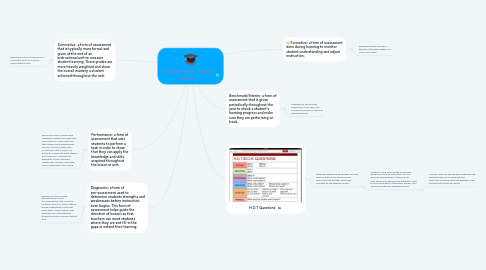Assessments by Danielle Kramer
by Danielle Kramer


1. Formative: a form of assessment done during learning to monitor student understanding and adjust instruction.
1.1. Examples of this include a thumbs up/thumbs down or a Think-Pair-Share
2. Summative: a form of assessment that is typically more formal and given at the end of an instructional unit to measure student learning. These grades are more heavily weighted and show the overall mastery a student achieved throughout the unit.
2.1. Examples of this include end of unit paper tests or a end of lesson Kahoot quiz
3. Diagnostic: a form of pre-assessment used to determine students strengths and weaknesses before instruction even begins. This form of assessment helps guide the direction of lessons so that teachers can meet students where they are and fill-in the gaps or extend their learning.
3.1. Examples of this include administering a short pre-assessment that could be multiple choice to collect data or giving a beginning of the year exam that is solely used to see what level of understanding students are at in a given content area
4. Performance: a form of assessment that asks students to perform a task in order to show that they can apply the knowledge and skills acquired throughout the lesson or unit.
4.1. Examples of this include have students illustrate and label their own made-up community and then explain each building and person's function within the community after a lesson on diversity or have students stage a mock election campaign for president of the classroom replete with slogans, speeches, voters registration and voting
5. Benchmark/Interim: a form of assessment that is given periodically throughout the year to check a student's learning progress and make sure they are performing on track.
5.1. Examples of this include beginning of the year MAP scores and middle of the year writing samples
6. H.O.T Questions
6.1. Opening: What kind of weather can you think of that you've experienced? How does the weather yesterday compare to the weather today?
6.1.1. Guiding: Using some of the vocabulary words we came up with, how can you describe the weather in this picture? Why would you describe the weather in this picture using those vocabulary words? Turn and share with your shoulder partner.
6.1.1.1. Closing: How can we use the vocabulary we learned today in our everyday life? How does knowing what the weather is like outside affect how we dress?

